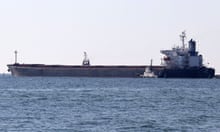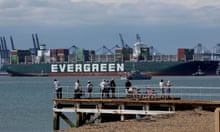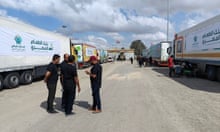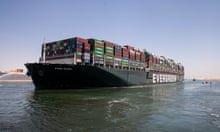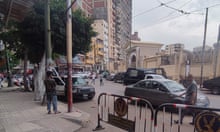One of the largest container ships in the world has been partially refloated after it ran aground in the Suez canal, causing a huge jam of vessels at either end of the vital international trade artery.
The 220,000-ton, 400-metre-long Ever Given – a so-called megaship operated by the Taiwan-based firm Evergreen – became stuck near the southern end of the canal on Tuesday. The Suez Canal Authority (SCA) said it had lost the ability to steer amid high winds and a dust storm.
Eight tugboats were working to free the vessel, blocking a lane key to Asia-Europe trade through which about 50 ships a day passed in 2019, according to Egyptian government statistics.
GAC, a Dubai-based marine services company, said the Ever Given had been partially refloated and moved alongside the canal bank, citing information from the SCA.
“Convoys and traffic are expected to resume as soon as the vessel is towed to another position,” GAC said on its website.
Bernhard Schulte Shipmanagement (BSM), the ship’s technical manager, said it ran aground in the canal at about 0540 GMT on Tuesday.
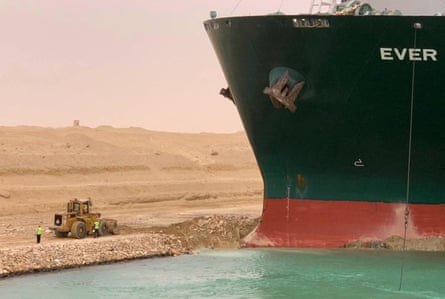
Egyptian forecasters said high winds and a sandstorm hit the area on Tuesday, with winds gusting as much as 31mph.
BSM said all crew were safe and accounted for, and there had been no reports of injuries or pollution.
A growing number of tankers were gathering near the entrance to the canal on Wednesday morning waiting to pass through. Seven vessels carrying 6.3m barrels of crude oil were among those unable to pass, the research firm Kpler said, with another three carrying an additional 2.5m barrels scheduled to try to make the passage by the end of the week.
The accident was probably due in part to strong winds that turned the containers above deck into a vast sail that blew the vessel off course, said Jamil Sayegh, a former captain and maritime law specialist with experience navigating the canal. “The force generated by the wind would have unintentionally altered the heading of the vessel,” he said.
But he added that human error may also have been a factor since ships traverse the canal in convoys and none of the vessels behind the Ever Given had run into similar troubles.
“Ships are machines run by propulsion engines with rudders that are almost identical in all vessels. The variables on board are the software and the personnel.”
Vessels passing through the Suez are obligated to use Egyptian pilots to help them navigate the stretch, he said.
Weather forecasts would have shown that winds were strong on Wednesday, but he said both canal authorities and mariners tried not to delay passage.
“If you delay this vessel at Suez anchorage, it means you are making the ship owner to lose $60,000 [£44,000] per day or $3-4000 per hour of delay,” said Sayegh, the Beirut agent for the shipping journal Lloyd’s.
The incentive not to pause journeys had grown more acute with the rise of just-in-time supply chains in recent decades, said Peter Sand, the chief shipping analyst with Bimco, an international association for shipowners.
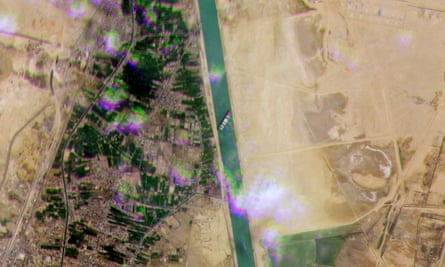
“For decades shipping has been the invisible conveyor belt at sea, enabling large manufacturing industries like automative to do just-in-time shipments, even though from time to time shippers are calling foul in terms of the reliability of the schedule,” he said. “Some production lines may be halted due to containers being caught in traffic like this.”
Lars Jensen, the chief executive of SeaIntelligence Consulting, said delays increased the risk of congestion at European ports. “When the canal reopens, this will mean that the delayed cargo will now arrive at the same time as cargo behind it which is still on track,” he said.
The Ever Given is one of a new category of ships called ultra-large container ships (ULCS), some of which are even too big for the Panama canal, which links the Atlantic and Pacific. It is carrying hundreds of containers bound for Rotterdam from China.
Pictures taken from another ship in the canal, the Maersk Denver, showed the Ever Given lodged at an angle across the waterway. Julianne Cona, who posted the picture on Instagram, watched the drama unfold as her ship waited at anchor.
“They had a bunch of tugs trying to pull and push it earlier but it was going nowhere,” she wrote.

Look at the size of the ship blocking the #SuezCanal if you zoom into the bow of the ship you can see a digger for size reference pic.twitter.com/428ha5ejav
— Brendan Cruise (@brendancruise) March 23, 2021
The Suez canal is one of the most important waterways in the world and links the Mediterranean with the Red Sea and shipping lanes to Asia. It is 120 miles (190km) long, 24 metres (79ft) deep and 205 metres wide and can handle dozens of giant container ships a day. It was expanded in 2015 to enable ships to transit in both directions simultaneously, but only in part of the waterway.

Its role as a cornerstone of international trade, particularly in oil, led the Egyptian president, Abdel Fatah al-Sisi, to announce an expansion of the vital waterway in 2014, a project promised as “a gift to the world”.
It cost $8bn after the Egyptian dictator demanded the project be completed within a year, promising Egyptian citizens that it would prove to be an “artery of prosperity”. Egypt welcomed world leaders to a grand ceremony marking the reopening of the new canal channel in 2015, amid a wave of nationalist fervour about the project.
Ships have been grounded in the canal before. In 2017, a Japanese ship became stuck but was refloated within hours. Away from the canal, a more serious incident occurred near the German port of Hamburg in 2016 when the massive CSCL Indian Ocean ran aground and needed 12 tugs to set it free after five days.
Additional reporting by Ruth Michaelson

